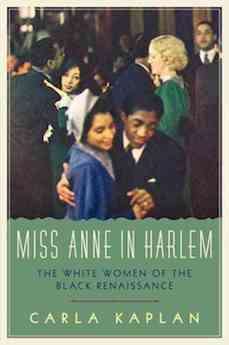By Kayleigh Whitman
While conducting research for her book Zora Neale Hurston: A Life in Letters (2003), Carla Kaplan made an unexpected discovery. Though ample material was available on Hurston’s black Harlem Renaissance associates and a fair amount on the white men, the author’s female white acquaintances were absent from the records. In a period that produced fresh female identities such as the “New Woman” and had witnessed the realization of women’s suffrage, the absence of documentation on white women active in the black renaissance captured Kaplan’s attention. Miss Anne in Harlem tells their story.
Contemporaneously both the white and African American communities often criticized these white women, collectively called “Miss Anne,” for their ventures into Harlem. The depiction often put forth by the papers and their peers was that they were driven by scandalous desires, spending their time and money in dark corners of jazz clubs on black lovers and strong drinks. In the absence of critical research, many of these opinions have endured. However, Kaplan has proven that Miss Anne has much to teach the contemporary reader about how Americans understood race during the early twentieth century and just as importantly, what these ideas can teach us about modern perceptions of identity. Six prominent women guide the reader through this important moment in American history all while providing insight into the motivations and subsequent difficulties of race crossing.
The setting for these outstanding narratives was severely conservative regarding race identification. The “one-drop rule” still reigned during this period and people on both sides of the color line went to great lengths to establish on which side they belonged. White Americans often adopted the idea that even one drop of black blood would contaminate one’s white ancestry, evident in the case of Alice Jones whose wealthy white husband Philip Rhinelander tried to annul their marriage after one month under pressure from his family. Jones’ mother was white and father a “mulatto.” When she was brought to trial on charges of tricking her husband into thinking she was white, Alice was forced to strip for the all male jury for an examination of her coloring. It was determined that deceit was impossible, and for the rest of her life she would remain the “colored girl” who married a Rhinelander.
African Americans faced difficulties with the “one-drop rule” beyond its obvious discriminatory effects as well. Many were eager to proclaim the ridiculous nature of blood identification, but at the same time desired those with black blood be proud of their racial inheritance—an idea essential to the Harlem Renaissance. In addition to the tension created by racial identification, there were questions regarding black representation by white writers and artists, white and black relations to Africa, and consensual sex between races. Miss Anne asked all of them.
Beginning with Lillian Wood who felt her calling was to live amongst the “colored people” of Tennessee, the reader is taken through some of the most provoking queries that still exist today. Josephine Cogdell Shuyler takes up the question of intermarriage and its impact on crossing in her marriage to the prominent African American editor George Schuyler. Through her relationship with George and his associates, she developed an ideology of identity as a political construct, something one creates rather than assumes at birth. Her husband took an even more radical view, declaring that race does not exist.
Countering these views were other women like Charlotte Osgood Mason and Nancy Cunard. Mason was dedicated to bringing primitive spirituality and culture to modern America, believing that white culture needed revitalization from African Americans. This could only be accomplished though by ensuring that black Americans avoided becoming “white Negroes” by looking to Africa. Unlike the Shuylers, Mason felt that race was an imperative component of identification and American culture. Nancy Cunard went further than Mason in her belief that identity was declarative and associative. She felt that she could be “one of them [African Americans], though still white.” Cunard was repeatedly criticized and sometimes threatened for “going Negro” by other whites. However, she craved the publicity that came with race crossing and used it to promote her belief in racial choice. Kaplan points out though that this insistence on race being a choice often alienated Cunard from Harlem blacks who knew all too well that any attempt to “choose” to be white could have dire consequences for those who made the attempt.
Through extensive research and brilliant writing, Carla Kaplan has brought life to women who have long been neglected by history. The resurrection of Miss Anne has come at an important time in the nation’s racial dialogue, providing a space for reflection and discussion about how our understandings have evolved over the past century or perhaps more importantly what has remained the same.
Kayleigh Whitman (ΦBK, Florida State University, 2014) graduated from Florida State University with a degree in history. She is currently a graduate student in the history department at Brandeis University (Mu of Massachusetts Chapter).




